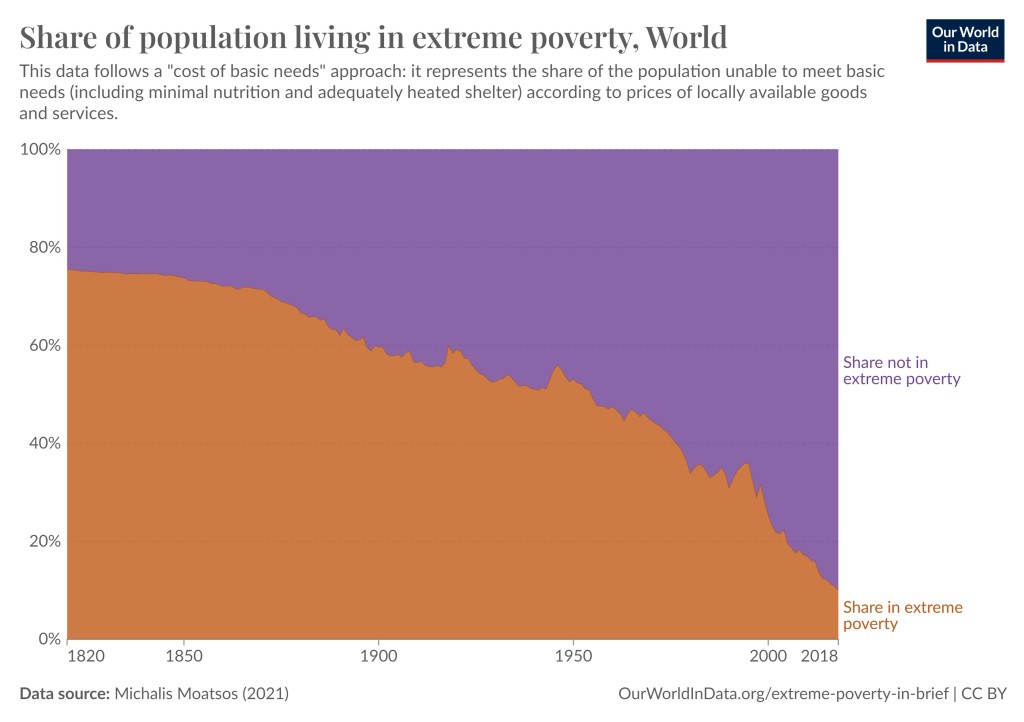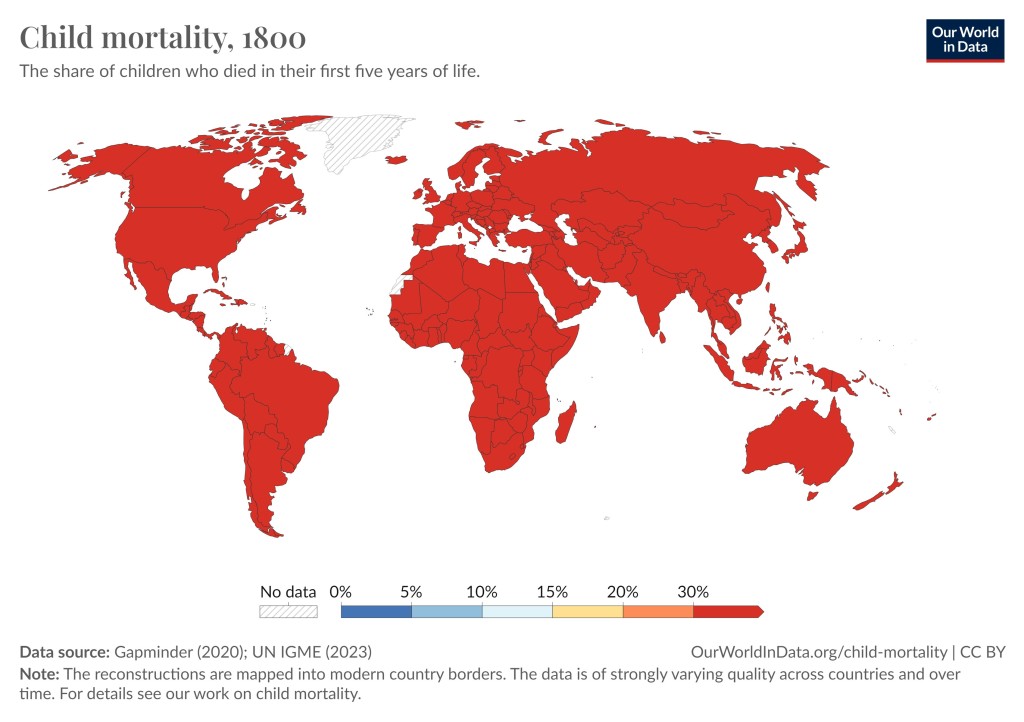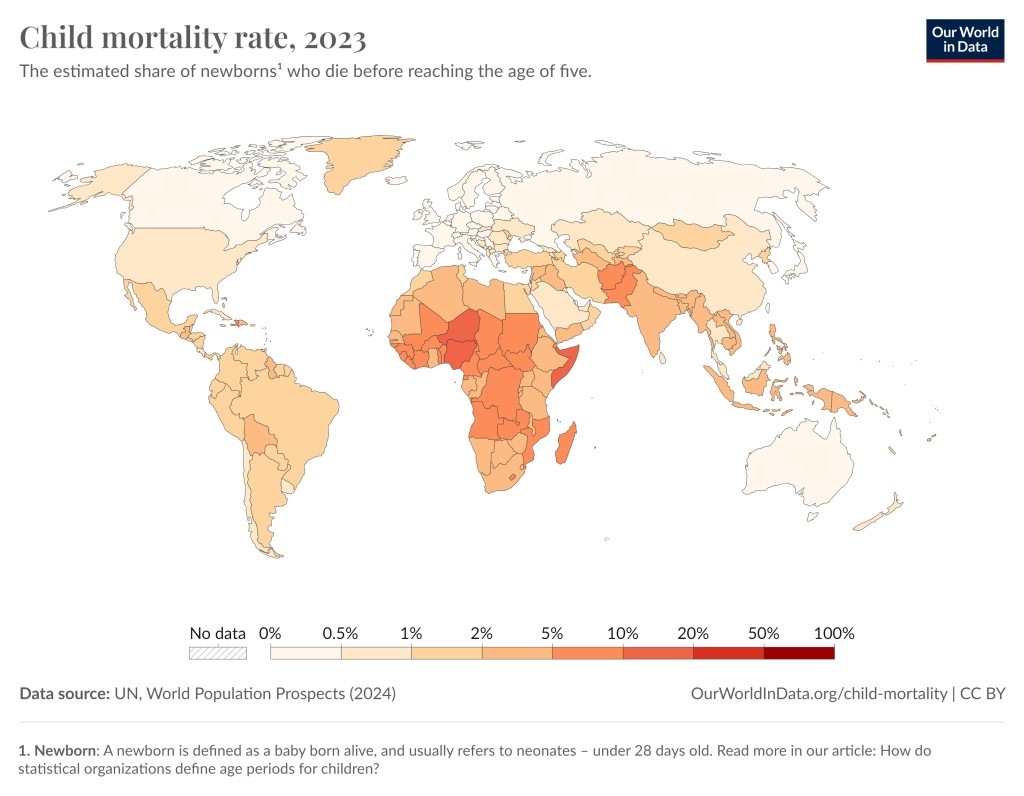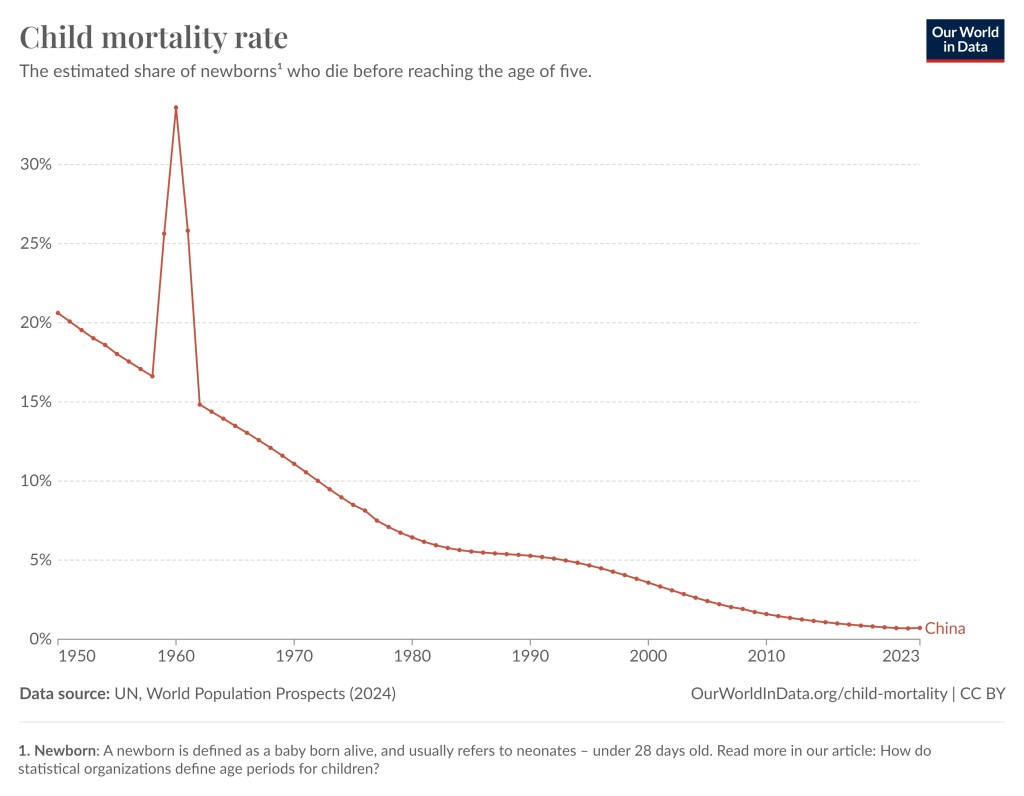Superfact 7 : Poverty and child mortality has been sharply reduced worldwide.
Extreme poverty as well as child mortality has been sharply reduced the world over. The countries that are the worst-off today are still better off than the countries that were doing the best at the beginning of the 19th century. Over the last 20 years extreme poverty and child mortality has continued to decline sharply.
In Hans Rosling’s book Factfulness, “Ten Reasons We’re are Wrong About the World – and Why Things Are Better Than You Think”, the author presented a quiz that he wanted the reader to take before reading the book. Below is the third question of the quiz. I should say that Hans Rosling posed this and other questions to thousands of people around the world.
In the last 20 years, the proportion of the World population living in extreme poverty has…
- A. Almost doubled
- B. Remained more or less the same
- C. Almost halved
The correct answer is C. Almost halved. Around 7% of the quiz takers got the right answer. Around 5% in the United States got it right. That the proportion of the World population living in extreme poverty halved in 20 years is a true fact. This is also an important fact about the world. Despite that most people got it wrong. In fact, monkeys randomly picking answers would do better (33%). I did pretty well on this quiz, but since I was reading the book and the book’s title is “Ten Reasons We’re are Wrong About the World – and Why Things Are Better Than You Think”, I got some help just looking at the front cover. In any case, I think this fact qualifies as a super fact, as do the other fact below (There has been a steep decline in child mortality).

There has been a steep decline in extreme poverty
According to the World Bank and Our Data World in Data, an organization which makes data in databases easily accessible to public, extreme poverty went from almost 80% 200 years ago, 60% 100 years ago, about 45% 50 years ago, 34.3% 30 years ago, 23.6% 20 years ago, 8.4% in 2019, then it went up to 9% during the covid epidemic but it seems to be back down to a bit above 8% again. See the graph below as well as the two linked articles in this paragraph.
I should say that extreme poverty is (by the UN, World Bank, etc.) “a condition characterized by severe deprivation of basic human needs, including food, safe drinking water, sanitation facilities, health, shelter, education and information” and is currently defined to be below $2.15. In 2011 it was below $1.90.

Other related statistics mentioned in Hans Rosling’s book is that the share of undernourished people went from 28% in 1970 to 11% in 2015. That is despite the earth’s growing population. Related to this is that cereal yield per hectare went from 1.4 ton in 1961 to 4 ton in 2014. This is due to modern agricultural techniques. The share of people with water from protected sources went from 58% in 1980 to 88% in 2015. This statistic was taken from WHO, UNICEF, the World Bank and FAO (the UN Food and Agriculture Organization).
There has been a steep decline in child mortality
According to Hans Rosling’s book the percent of children dying before their fifth birthday went from 44% in 1800 to 4% in 2016. To get a more complete picture see these articles from Our World In Data, article1, article2, as well as the graph below. For most of humanities existence virtually all societies suffered a child mortality rate between 40% and 60%, but that changed drastically over the last 100 years.



Below is the child mortality rate since 1950 for a few selected countries.





Perhaps part of what skewers our perception is ready mass media—and, of course, selective memory. Killing has never been as efficient as it is in the present, but people died in wars of things like infection and disease more readily in the past than they do now. For example, a distant relative of mine died during WWI of the 1918 Flu. To the best of my knowledge, he never saw combat.
Thanks for this.
LikeLiked by 1 person
Yes you are right Denise. People died of things like infection and disease and famine more readily in the past than they do now and it is often included in the death or casaulty count for the war. I should say that the Spanish flu is typically not included in the count for World War I though. However, your comment makes it clear that my presentation on the war and violence section is not well done. I need talk about the points you bring up and I need to include more references and be clearer. Besides I put three super facts in one post that is more than 2,000 words long plus a bunch of graphs. I should have put the war and violence section in its own post and low and behold I had planned to do that anyway in the upcoming post “We are living in relatively peaceful times”. So I am going to delete that part from this post and write a much better one under the title “We are living in relatively peaceful times”.
LikeLiked by 1 person
I’m sorry, Thomas. I didn’t intend to find fault. And I sure didn’t mean to make for work for you. 🙂 It was the only example I could think of off the top of my head. But before antibiotics, I imagine there was a lot of infected wounds and things like gangrene.
There is this guy. I know of him because I went to high school near where his house still stands.
Nicholas Herkimer – Wikipedia
LikeLiked by 1 person
No I did not think you found faults. I just thought your comment was insightful and it got me thinking. I was thinking that the post was already long enough when I added a third “super fact” that I felt I rushed through. That’s all. You just made me think, which is never bad. The Nicholas Herkimer anecdote was interesting. Thank you Denise.
LikeLiked by 1 person
thanks. I thought the whole post was thought-provoking and interesting.
LikeLiked by 1 person
Thank you so much Denise
LikeLiked by 1 person
Quality of life definitely increases with modern medicine, science, and technology. I’m glad you have showed this so well in your post. It’s interesting to read the stats!
LikeLiked by 2 people
Yes I think you stated that very well. Thank you so much Sara.
LikeLiked by 1 person
Hi Thomas, living in a third world African country, I find these figures quite hard to understand. Southern Africa is in a very bad way and millions of people live in dire poverty. I understand a similar situation exists in India.
LikeLiked by 1 person
I can understand that. South Africa is one of the few countries in the world where extreme poverty has increased. Sub Saharan Africa in general has not been very successful in this area. However, China and also India has made great progress in this area and they are nearly half the world’s population. My father in-law went to India in the 1970’s on business trips and he was appalled by the wide spread extreme poverty that he saw. I went to India in 2014 on a business trip and I had a very different experience. I did not see much poverty and most people I met were living comfortable lives. However, I stayed in the city. I know the country side is worse off.
I mentioned Hans Rosling above, a Swedish doctor who spent most of his life trying to help people in the developing countries. He writes that he witnessed significant improvements in health and reduction in extreme poverty all around the world. That is one reason he got into examining the statistics collected by various organizations. The statistics from the various the sources told the same story. It is getting better over all, but not all places are catching up.
LikeLike
Hi Thomas, this all makes sense. Certainly China has made great progress in uplifting its people. India I wasn’t sure about as I still hear of a lot of poverty there but I have never visited. My knowledge is from the news and social media. Southern Africa is going backwards.
LikeLiked by 1 person
I saw on the World Banks website that in 2023 India’s GDP grew by 7.6% and South Africa’s grew 0.6%. Indian real GDP growth have averaged more than 6% per year since 2006, about double as much as the average in the rest of the world. There is still a lot of poverty in India but they are growing out of it. I really hope South Africa will turn around and do better.
LikeLike
Time will tell. The new Government of National Unity has given people hope.
LikeLiked by 1 person
Mortality rates are bound to decrease, with new discoveries in medicine and technology, but my perception about poverty is that it is still a major problem throughout the world. It surprised me to learn it has decreased to such a great extent! Nice to have a little good news, for a change. 🙂
LikeLiked by 1 person
Yes you are right and poverty is still a big problem in the world, especially in subaharan Africa. However, extreme poverty has been reduced a lot. Poverty (regular) as defined by less than $6.15 per day is still pretty high, like 50%. But first people has to move out of extreme poverty, because that kind of poverty is killing people.
LikeLiked by 1 person
Excellent research, Thomas. Thank you for underscoring how the human family has learned to care for itself better. I was unaware of some of your research data.
LikeLiked by 1 person
Thank you so much Gwen. Luckily there are organizations such as Our World in Data, Gapminder, Pew research center and the World Bank, that does the real research, then proivde it for free for us to discover.
LikeLiked by 1 person